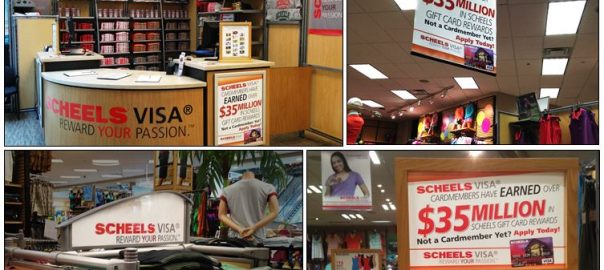Creating an effective in-store marketing presence for a co-brand card is a challenge facing almost all retailers. To better understand the current landscape and develop a useful set of insights-to-action, Media Logic conducted an in-store audit across more than 30 different retail brands.
Overall, we found that co-brand card marketing is not only secondary to retail merchandising, but also not well executed. The good news is there are actionable steps retailers can take to increase the efficacy of co-brand card marketing, optimize new cardholder acquisition and increase usage among existing cardholders.
Here are seven ways you can boost your in-store co-brand marketing efforts:
Strategy 1: Approach card efforts holistically
Take an integrated approach to your in-store efforts so the total consumer experience is cohesive and unified. This includes everything from determining the most effective and scalable channels for card marketing in your retail space to using calls-to-action that are strong, visible and create urgency (and help drive sales).

Scheels, a large sporting goods retailer, prominently promotes its card in-store using a high concentration of tabletop and rack signage, hanging posters and a dedicated tabling kiosk in all of its store locations. Scheels merchandises all departments, POS, customer service and fitting room areas with card signage. Card kiosks display acquisition premiums and sales video LCDs.
Strategy 2: Prioritize in-store card marketing over loyalty program marketing
Whenever possible, focus on communicating the co-brand card’s value proposition as a way to promote the loyalty program. Position the card as the primary way to take advantage of the loyalty program and evaluate in-store channels to schedule and place merchandising options that allow for the concurrent promotion of the co-brand card.
Strategy 3: Use strong and consistent messaging
Take advantage of consumer affinity for your retail brand through card promotions and merchandising that align with, and extend, the brand. Promote and merchandise the card’s value proposition and use messaging such as “exclusively for cardmembers” and “special offer only with card.” You should also highlight additional benefits that are only available with the card (such as free shipping, advance sales notice, etc.).
Be sure to present your card’s earn-and-burn structure in a simple, compelling manner. Use visual aids like charts and graphics to support your messaging. And, finally, consider rich offers to incent in-store application and activation. If possible, consider offers designed to drive card use within first month on book.
Strategy 4: Scale investment and effort to your needs
There is no “one-size-fits-all” approach to best-in-class merchandising. And the size of a retail establishment doesn’t influence the effectiveness of its co-brand marketing efforts. Many large chains do a less than stellar job, while some small stores market their co-brand cards well.
What is important is the physical placement of co-brand card marketing efforts. Strive for visibility over volume as a key driver of success. Pay attention to the traffic flow in your stores and think beyond traditional take-one/signage placement as appropriate for your brand.

For a small store with limited space, Gymboree’s card merchandising is impactful. The brand displays collateral and signage in front of the register, and a single oversize sign promotes the card at store entrances. Employees also wear lanyards promoting the card by name.
Strategy 5: Develop and implement card merchandising protocols
Consider placing co-brand card promotion fixtures in the front of the store where full-price merchandise is being shopped and motivation will be higher amongst your customers. And, to the extent possible, ensure your fixture installments are consistent across multiple store locations. To ensure card collateral is well managed, assign a corporate employee to be responsible for card merchandising and maintenance.
Strategy 6: Leverage technology for in-store card promotion
Use all available technology to promote the card, including PIN pads, register queue display monitors, receipt messaging, TV displays, etc. Video content is important to display in high-traffic and captive audience locations.
If your co-brand card has a mobile app, don’t be afraid to promote it, as well. While it may seem counterintuitive, digital channels have been shown to successfully augment in-store efforts.

T.J.Maxx uses dressing room LCD Panels with an animation loop to promote a 10% off first-purchase acquisition offer. Banana Republic signature pads merchandise both private label and Visa cards equally. Best Buy uses a combined message on signature pads to remind cardholders of card benefits (rewards or flexible financing) and incite non-cardholders with an “apply today” CTA.
Strategy 7: Effectively train and motivate sales associates
Best-in-class co-brands have training programs ranging from one-on-one training sessions to intranet-based educational modules. Sales tools, such as customer-facing collateral, are also invaluable aids in the card selling process.
Sales promotions are another effective tool to help turn employees into card ambassadors. Be sure to use meaningful incentives (a bonus with perceived low value will not encourage associates to actively sell cards) and make sure employees understand how the promotion works.
Finally, encourage employees to apply for and use the co-brand card themselves. It’s a wonderful opportunity for all employees – from management to associates – to understand the value of the card firsthand.
Employing these seven principles will give your retail environment the edge it needs to effectively promote your co-brand card without competing with merchandising and marketing initiatives. In fact, an effective co-brand card marketing effort will only serve to maximize these other initiatives, as well as direct-to-consumer initiatives developed in partnership with the card issuer.
Business & Finance Articles on Business 2 Community(237)
Report Post






